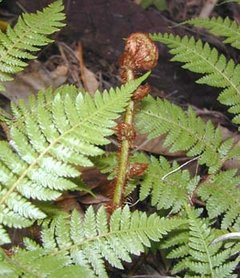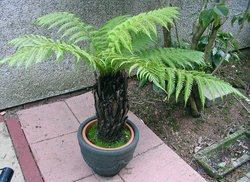Cyatheales
|
|
| Tree fern (Cyatheales) | ||||||||||
|---|---|---|---|---|---|---|---|---|---|---|
 Australian Tree Fern | ||||||||||
| Scientific classification | ||||||||||
| ||||||||||
| Familes and Genera | ||||||||||
|
Cyatheaceae |
The order Cyatheales is a taxonomic division of the fern (Division Pteridophyta) subclass, Cyatheatae, which includes the Tree ferns.
In general, any fern that grows with a trunk elevating the fronds (leaves) above ground level can be called a tree fern. However, the plants formally known as tree ferns compose a group of large ferns belonging to the families Dicksoniaceae and Cyatheaceae in the order Cyatheales.
Tree ferns are found growing in tropical and subtropical areas, including cool to temperate rainforests in Australia, New Zealand and neighbouring regions (e.g. Malaysia, Lord Howe Island, etc.); a few genera extend further, such as Culcita in southern Europe. Like all ferns, tree ferns reproduce by means of spores developed in sporangia on the undersides of the fronds.
The fronds of tree ferns are usually very large and multiple-pinnate. At least one type, however, has entire (undivided) fronds. The fronds of tree ferns also exhibit circinate vernation, meaning the young fronds emerge in coils that uncurl as they grow.
Unlike flowering plants, tree ferns do not form new woody tissue in their trunk as they grow. Rather, the trunk is supported by a fibrous mass of roots that expands as the tree fern grows.
Some tree fern genera, e.g. Dicksonia and Cibotium, but not Cyathea, can be transplanted by severing the top portion from the rest of the trunk and replanting it elsewhere. If the transplanted top part is kept moist, it will regrow a new root system over the next year. The success rate of transplantation increases to about 80% if the roots are dug up intact. If the crown of the Tasmanian Tree Fern, Dicksonia antarctica (the most common species in gardens) is damaged, it will inevitably die because that is where all new growth occurs. But other clump-forming tree fern species, such as D. squarrosa and D. youngiae, can regenerate from basal offsets or from "pups" emerging along the surviving trunk length. Tree ferns often fall over in the wild, yet manage to re-root from this new prostrate postion and begin new vertical growth.
It is not certain how many species of tree fern there are, but it is likely to be around a thousand. New Guinea produces new species with each botanical survey. On the other hand, many species have become extinct in the last century as forest habitats have come under pressure from human intervention.
Other tree ferns
Outside of the Cyatheales, a few ferns in other groups could be considered tree ferns, such as several ferns in the family Osmundaceae, which can achieve short trunks under a metre tall, and a few species in the genera Blechnum, Leptopteris, Sadleria and Todea could also be considered tree ferns in a liberal interpretation of the term.
The families that constitute Cyatheales have been relatively firmly established as a monophyletic clade by DNA sequencing and morphological studies. The order Plagiogyriales, which contains the family Plagiogyriaceae, is most closely related to the Cyatheales, not to the Osmundales as had been previously supposed.
References
- Pryer, K.M., A.R. Smith, and J.E. Skog. 1995. Phylogenetic relationships of extant ferns based on evidence from morphology and rbcL sequences. American Fern Journal 85: 205-282.
- Braggins, John E. and Large, Mark F. Tree Ferns. Timber Press (2004).de:Baumfarn


